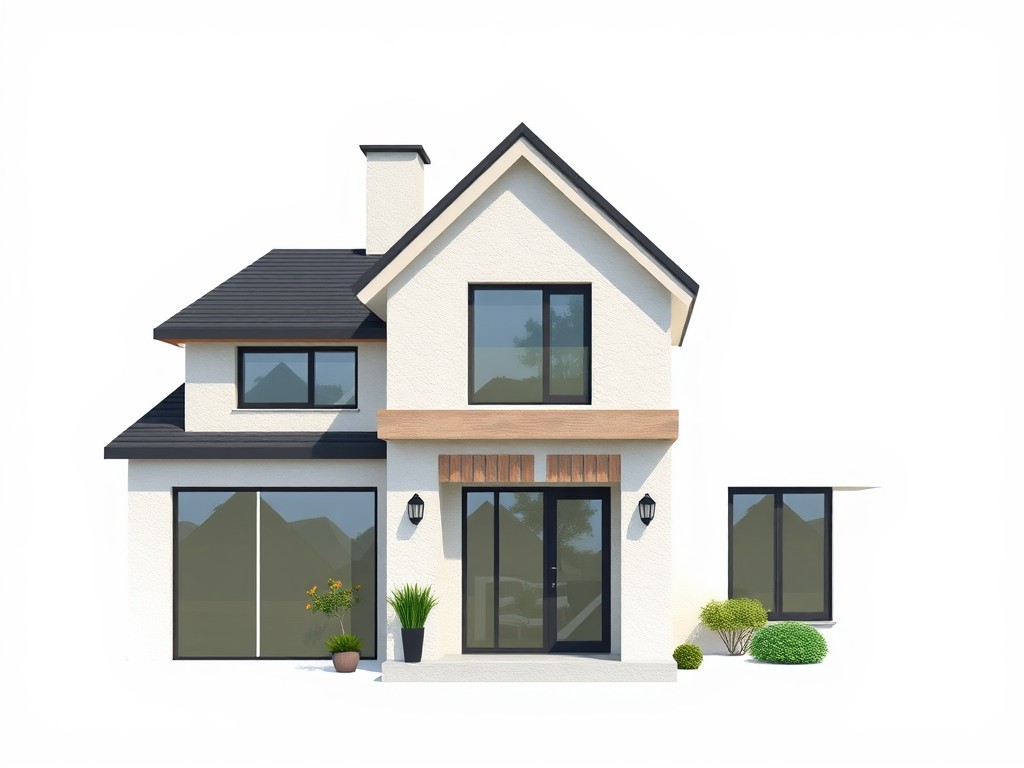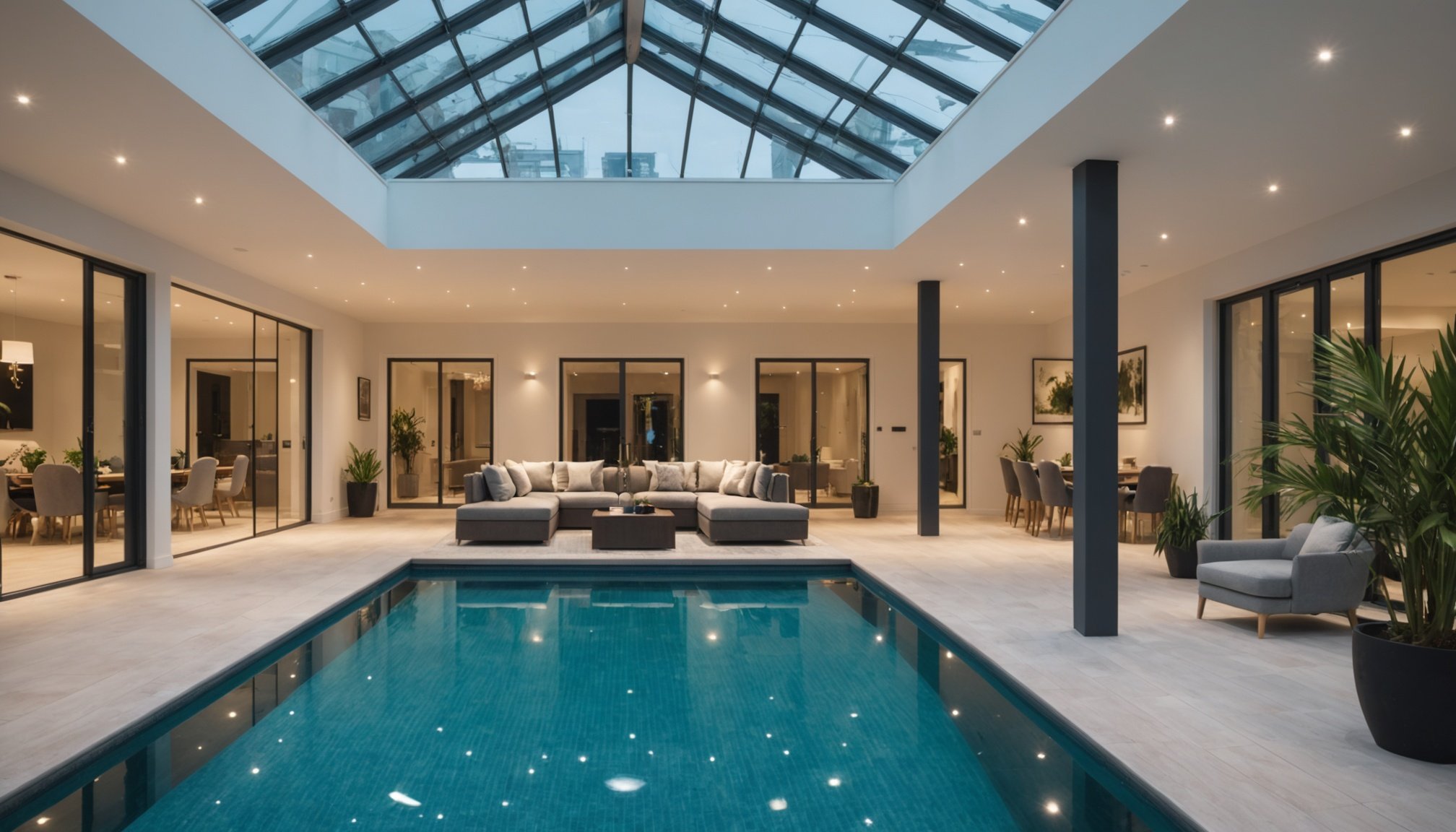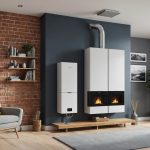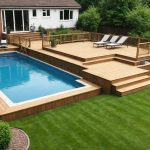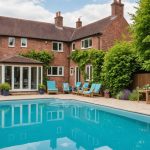Understanding Dual-Purpose Pools
Dual-purpose pools are an innovative solution for those looking to balance relaxation and fitness within a single water feature. Designed with versatility in mind, these pools cater to multiple uses—whether you want to unwind or engage in rigorous exercise. Key factors in their design can enhance both functions seamlessly.
Incorporating dual-purpose features requires a thoughtful approach to pool design. For instance, integrating varying depths allows for a relaxation pool area that is more shallow, while deeper sections accommodate lap swimming. Other considerations include adjustable water temperatures and jets for hydrotherapy, ensuring a soothing experience.
Lire également : Creative Strategies for Designing a Tiered Pool Deck in Your Sloped UK Backyard
Key features such as built-in swim jets facilitate a stationary swimming experience, making the pool suitable for fitness training. Similarly, ergonomic seating and ambient lighting can enhance the relaxation aspect, creating a tranquil environment.
Multiple elements like dual-purpose pools, pool design, and relaxation pool create a balance between leisure and exercise. Whether aiming for leisurely float or high-intensity swimming, dual-purpose pools provide a customized experience tailored to your unique needs.
Sujet a lire : Transform Your UK Home: Designing a Safe and Fun Pool Area for Kids
Design Ideas for Stylish Dual-Purpose Pools
Creating a harmonious blend between aesthetics and functionality involves clever pool design ideas. Think of dual-purpose pools that elegantly marry leisure and exercise needs.
Incorporating Relaxation Areas
Relaxation zones can transform a pool space into a serene escape. Integrating plush loungers around the poolside provides ultimate comfort. Consider adding spa features like a built-in jacuzzi or waterfall, enhancing both the design and the user’s experience. These elements cater beautifully to those seeking tranquility, making it an idyllic spot for unwinding.
Designing for Swim Zones
For fitness enthusiasts, creating efficient swim zones is crucial. Optimal lane spacing and varied depths cater to different skill levels and exercise routines. A separate lap lane offers a dedicated area for focused workouts without compromising on other recreational spaces. Space optimization ensures a seamless transition between relaxing and active areas, maintaining a balance.
Utilizing Natural Light
Maximizing natural light is pivotal in creating an inviting pool environment. Architectural features, such as strategic placement of windows or skylights, enhance sunlight presence. This not only improves the aesthetic appeal but also reduces the need for artificial lighting. An aesthetic integration of light and surroundings makes the pool area vibrant and energy-efficient.
Benefits of a Dual-Purpose Pool
Dual-purpose pools offer a unique combination of relaxation and fitness opportunities. By incorporating swimming into your daily routine, you can enjoy substantial health advantages. Swimming is an excellent cardiovascular exercise, promoting endurance and strengthening muscles, all while being gentle on the joints. It provides a full-body workout that can be customised to meet various fitness levels.
Beyond physical benefits, these pools cater to mental well-being. The relaxation features, such as spa jets and seating areas, provide an oasis of peace of mind, allowing users to unwind after a strenuous day. This relaxation reduces stress and improves mood, fostering an environment for social interaction and family gatherings which strengthen bonds.
From a practical perspective, dual-purpose pools are both space-saving and cost-effective. By integrating relaxation and fitness elements within one design, homeowners can maximise their backyard’s utility without excessive expenditure on separate facilities. This makes them an attractive investment that enhances a property’s value while efficiently using available space. By merging recreation and relaxation, dual-purpose pools present a compelling option for those seeking the best of both worlds in their own backyard.
Construction and Maintenance Tips
Building and maintaining a pool requires careful consideration of the construction materials and upkeep methods. This ensures longevity and aesthetic value.
Choosing the Right Materials
Selecting the appropriate construction materials is crucial for pool durability and aesthetics. Options include concrete, fibreglass, and vinyl. Concrete offers custom shapes but may require more maintenance. Fibreglass is less customisable, yet more resistant to mould. Vinyl provides affordability and a smooth surface but may need frequent liner replacements.
Regular Maintenance Practices
Routine pool maintenance is essential to maintain water quality and equipment longevity. Consider these practices:
- Skimming debris and cleaning filters regularly
- Monitoring and balancing chemical levels
- Checking and maintaining pool equipment such as pumps and heaters
This regular upkeep helps ensure the pool remains a safe and inviting environment, whether for fitness or relaxation.
Engaging Professionals vs. DIY
When it comes to pool construction and pool maintenance, deciding between hiring professionals or undertaking DIY projects is significant. Engaging professionals brings expertise and efficiency, albeit at higher costs. Alternatively, a DIY approach provides savings and personal satisfaction but requires time and knowledge. Assess your budget and skill level before making a choice.
Integrating Landscaping with Your Pool
Designing your outdoor space around a pool can transform it into a seamless extension of nature. The key is to harmonize your pool design with the surrounding landscape, creating a cohesive aesthetic. Start by choosing plants and materials that complement each other. Native plants are an excellent choice as they integrate easily and require less maintenance, adapting well to your local climate.
When selecting materials for poolside areas, consider natural stone or wood for an earthy feel. These materials can enhance the overall nature integration, making the pool seem like a natural water feature. Plant colourful flowers or greenery strategically at the pool’s edges to soften the hard lines and add visual interest.
An inviting outdoor environment isn’t just about relaxation; it also promotes fitness. Incorporating a variety of seating areas, such as lounge chairs and dining sets, encourages different activities and maximizes the versatility of your space. Consider adding pathways or stepping stones to connect various sections of the garden, creating a unified flow.
Ultimately, by implementing thoughtful landscaping ideas, you can achieve a tranquil and aesthetically pleasing poolside atmosphere that invites both relaxation and movement.
Equipment Recommendations for Dual-Purpose Pools
Dual-purpose pools are ideal for both fitness and relaxation, requiring unique pool equipment suited to these needs. A well-equipped pool can provide a versatile environment, enhancing both workouts and leisure time.
Swim Training Equipment
For those seeking to use their pool as a fitness tool, investing in equipment like resistance bands and aquatic dumbbells can boost results. Similarly, swim fins and paddles can enhance your swimming technique by increasing resistance and building strength. A swim tether is another valuable tool, allowing for continuous swimming in smaller pools.
Relaxation Enhancements
Enjoying your pool for relaxation is just as important. Accessories such as floating loungers and waterproof music players can transform your pool into a haven of tranquility. Water fountains or bubblers can add a soothing touch, transforming the ambiance and making the relaxation experience more immersive and enjoyable.
Maintenance Equipment
Regular maintenance is essential for an enjoyable pool experience. Robotic pool cleaners and pool covers are indispensable, saving time and ensuring cleanliness. Additionally, investing in a quality pool skimmer and chemical testing kit ensures your pool remains safe and welcoming for both exercise and relaxation activities.
Cost Estimates for Building a Dual-Purpose Pool
Estimating pool construction costs is an important first step when planning your dream pool. In the UK, the average construction cost can vary greatly depending on the design. For instance, a basic above-ground pool starts at around £3,000, while a more elaborate in-ground pool can exceed £80,000. Size, shape, and materials are key factors influencing these costs.
When undertaking budget planning, it’s crucial to account for additional expenses such as landscaping and accessories. These elements not only enhance the aesthetic appeal but can also add considerable value. Allocating funds for a deck, heating system, or pool cover can often range between £5,000 and £15,000, depending on the scope of the project.
The investment value of a dual-purpose pool extends beyond initial costs. Many homeowners find that enhancing their outdoor space adds significant long-term value. Not only does a well-designed pool increase property desirability, but it can also boost the market price substantially. Considering return on investment, a carefully planned pool often pays for itself both in pleasure and financial returns, making it a savvy addition to any property.
UK-Specific Regulations and Climate Considerations
Understanding the UK’s specific regulations and climate impact is essential when considering pool construction. The UK has strict building codes that require compliance to ensure safety and sustainability.
Local Building Regulations
Local building regulations in the UK are paramount when constructing a pool. These codes cover aspects like pool fencing, water circulation systems, and safety measures. Builders must adhere to standards ensuring the pool can withstand environmental elements without compromising safety. Ignoring these regulations can result in penalties or the need to rebuild parts of the structure, adding unforeseen costs.
Climate Considerations for Design
The UK climate significantly influences pool design and usage. With frequent rain and cooler temperatures, pools in the UK require efficient heating systems. Selecting materials resistant to the UK’s climatic conditions, such as corrosion-resistant metals, can increase the pool’s longevity. Consideration of these factors ensures the pool remains useable and cost-effective throughout various weather conditions.
Seasonal Maintenance Needs
Seasonal maintenance in the UK requires unique attention due to fluctuating weather. Regular checks for algae, especially after heavy rainfall, and ensuring efficient heating system operations during colder months are crucial. Proper seasonal maintenance ensures the longevity of the pool and optimal operation year-round.
